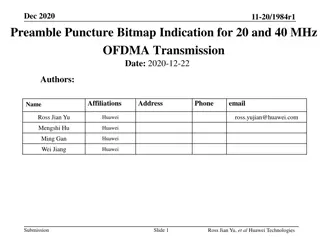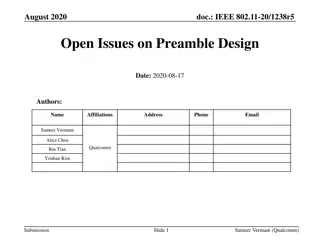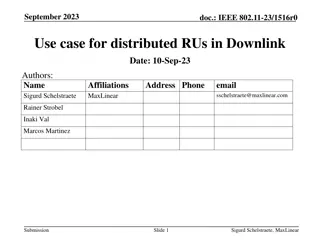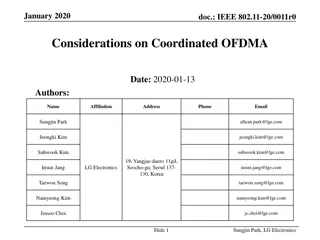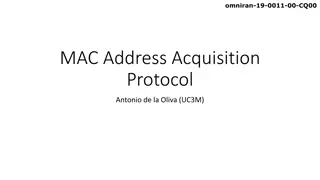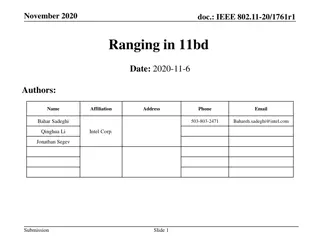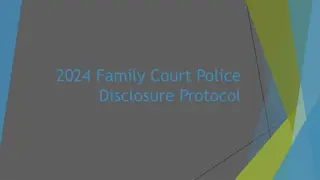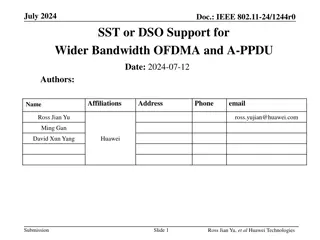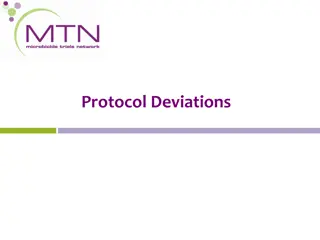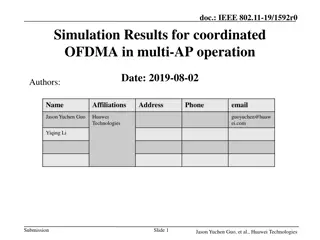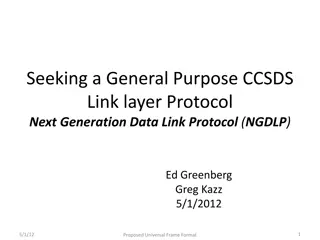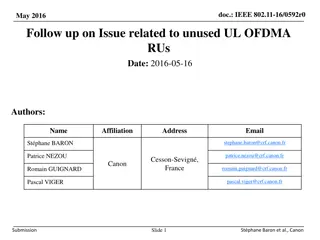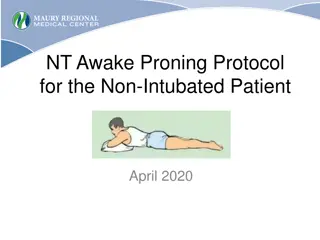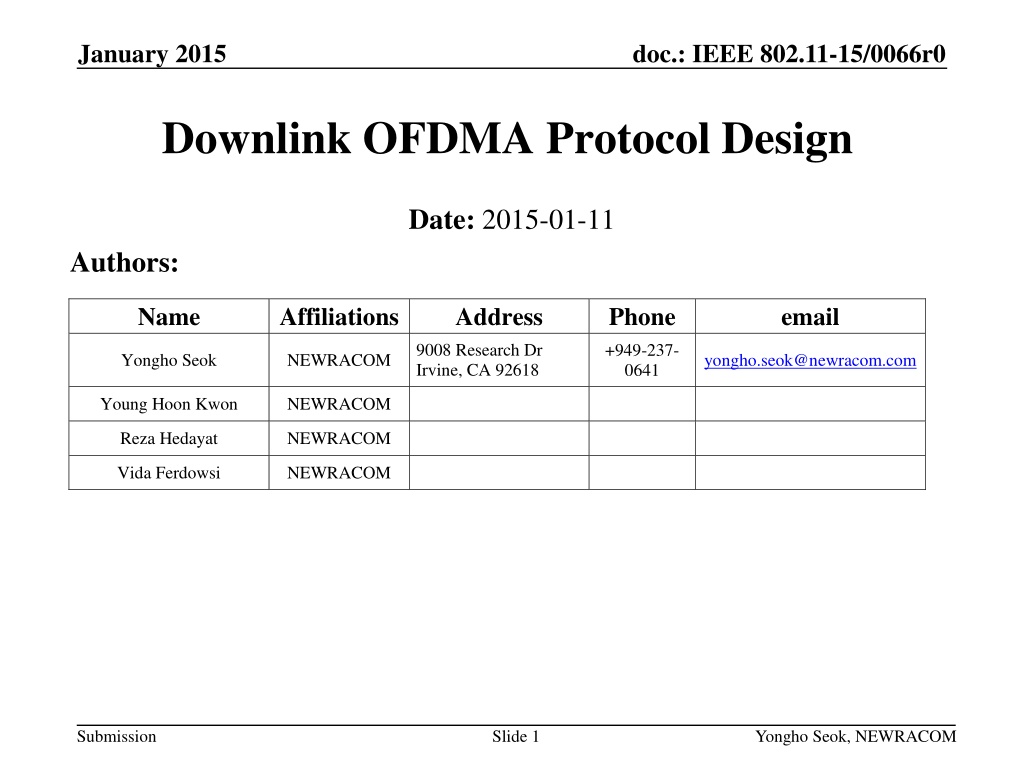
IEEE 802.11-15/0066r0 Downlink OFDMA Protocol Design
Explore the design and implementation of the downlink OFDMA protocol in IEEE 802.11-15/0066r0 for effective frequency selective scheduling. The document delves into key aspects such as frequency selectivity information, sub-channel assignment structure, and general procedures for transmitting OFDMA PPDU, aiming to enhance the efficiency and performance of wireless communication systems.
Download Presentation

Please find below an Image/Link to download the presentation.
The content on the website is provided AS IS for your information and personal use only. It may not be sold, licensed, or shared on other websites without obtaining consent from the author. Download presentation by click this link. If you encounter any issues during the download, it is possible that the publisher has removed the file from their server.
E N D
Presentation Transcript
January 2015 doc.: IEEE 802.11-15/0066r0 Downlink OFDMA Protocol Design Date: 2015-01-11 Authors: Name Affiliations Address Phone email 9008 Research Dr Irvine, CA 92618 +949-237- 0641 Yongho Seok NEWRACOM yongho.seok@newracom.com Young Hoon Kwon NEWRACOM Reza Hedayat NEWRACOM Vida Ferdowsi NEWRACOM Submission Slide 1 Yongho Seok, NEWRACOM
January 2015 doc.: IEEE 802.11-15/0066r0 OFDMA Support in High Efficiency (HE) BSS TGax Specification Framework [1] 4. Multi-user (MU) features This section describes MU related features. MU features include UL and DL OFDMA and UL and DL MU-MIMO. But, in order to sustain a gain of OFDMA, the frequency selective scheduling is very important [5] This document discusses the Downlink OFDMA protocol design to enable the frequency selective scheduling Submission Slide 2 Yongho Seok, NEWRACOM
January 2015 doc.: IEEE 802.11-15/0066r0 Downlink OFDMA General Procedure First step is that HE AP obtains the frequency selectivity information of the recipient STAs Second step is that HE AP determines the sub-channel assignment structure based on the frequency selectivity information HE AP transmits the Downlink OFDMA PPDU wherein the sub-channel assignment structure is contained in the PHY header Submission Slide 3 Yongho Seok, NEWRACOM
January 2015 doc.: IEEE 802.11-15/0066r0 Frequency Selectivity Information The frequency selectivity information of recipient STAs can be obtained in an explicit or implicit manner The recipient STA may report its frequency selectivity information to HE AP in a solicited or unsolicited manner For example, the recipient STA may include its frequency selectivity information in the ACK frame, similarly to the Link Adaptation mechanism of 11ac Also, HE AP can estimate the frequency selectivity information of recipient STAs from any received frames Assume the channel reciprocity between HE AP and recipient STA Submission Slide 4 Yongho Seok, NEWRACOM
January 2015 doc.: IEEE 802.11-15/0066r0 Sub-channel Assignment Structure HE AP determines the sub-channel assignment structure for segmenting the Channel Bandwidth into a set of sub-channels The sub-channel assignment structure is included in PHY Header All sub-channels in the sub-channel assignment structure are assigned to recipient STAs Submission Slide 5 Yongho Seok, NEWRACOM
January 2015 doc.: IEEE 802.11-15/0066r0 Sub-channel Assignment Structure The recipient information of the Downlink OFDMA PPDU should be also signaled in the PHY Header Each recipient receives the addressed PSDU on its assigned sub-channel identified by the Sub-channel Assignment Structure field Submission Slide 6 Yongho Seok, NEWRACOM
January 2015 doc.: IEEE 802.11-15/0066r0 Sub-channel Assignment Structure The recipient information of the Downlink OFDMA PPDU can be signaled by the Association ID (13 bits), Partial AID (9 bits) or Group ID (6 bits) Since the available bits of PHY Header is very limited, Partial AID or Group ID has a benefit for reducing the signaling overhead Submission Slide 7 Yongho Seok, NEWRACOM
January 2015 doc.: IEEE 802.11-15/0066r0 Sub-channel Assignment Structure When Partial AID is used to indicate the recipient information of the Downlink OFDMA PPDU, HE AP have to carefully schedule recipient STAs to avoid the ambiguity of the sub-channel determination If the partial AIDs of the recipient STAs in the Downlink OFDMA PPDU is same, the corresponding recipient STAs can not identify their assigned sub-channel Submission Slide 8 Yongho Seok, NEWRACOM
January 2015 doc.: IEEE 802.11-15/0066r0 Sub-channel Assignment Structure When Group ID is used to indicate the recipient information of the Downlink OFDMA PPDU, HE AP have to carefully schedule recipient STAs to avoid the ambiguity of the sub-channel determination If a recipient STA has memberships of a plurality of Group IDs, the corresponding recipient STA can not identify its assigned sub- channel In the below figure, even though AP does not transmit any space time stream with the Group ID 2, 3 and 4 to STA1, STA1 does not know its sub-channel. This situation should be avoided. Submission Slide 9 Yongho Seok, NEWRACOM
January 2015 doc.: IEEE 802.11-15/0066r0 Conclusion This document presents the Downlink OFDMA protocol design considerations the frequency selectivity information of the recipient STA the sub-channel assignment structure to the recipient STA Also, this document proposes the PHY Header design consideration of the Downlink OFDMA PPDU Because TGax Specification Framework decided to support the Uplink OFDMA and Uplink MU-MIMO, the final PHY Header design should be harmonized with all other features Submission Slide 10 Yongho Seok, NEWRACOM
January 2015 doc.: IEEE 802.11-15/0066r0 References [1] https://mentor.ieee.org/802.11/dcn/14/11-14-1453-02- 00ax-spec-framework-proposal.docx [2] https://mentor.ieee.org/802.11/dcn/14/11-14-1210-01- 00ax-hew-ppdu-format-for-supporting-mimo-ofdma.pptx [3] https://mentor.ieee.org/802.11/dcn/14/11-14-1211-00- 00ax-ack-procedure-for-ofdma.pptx [4] https://mentor.ieee.org/802.11/dcn/14/11-14-1417-00- 00ax-hew-ppdu-transmission-discussion.pptx [5] https://mentor.ieee.org/802.11/dcn/14/11-14-1452-00- 00ax-frequency-selective-scheduling-in-ofdma.pptx Submission Slide 11 Yongho Seok, NEWRACOM


